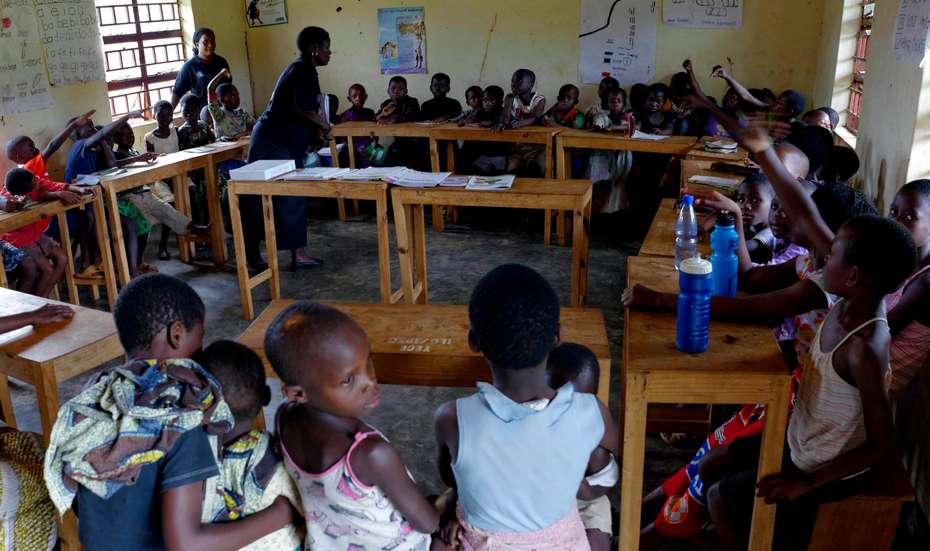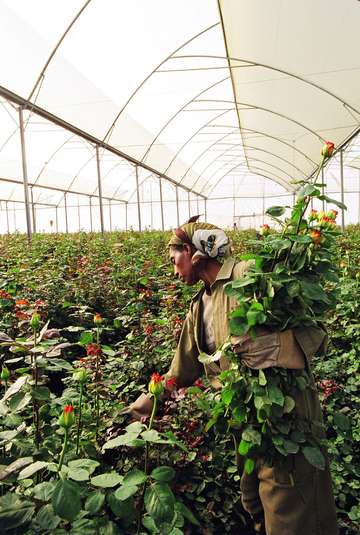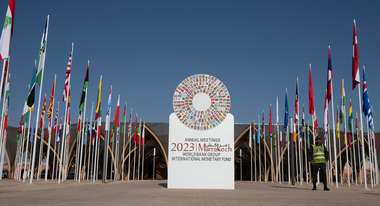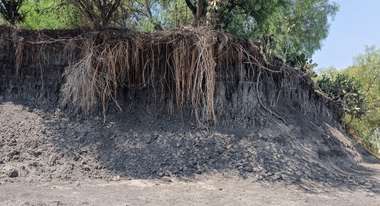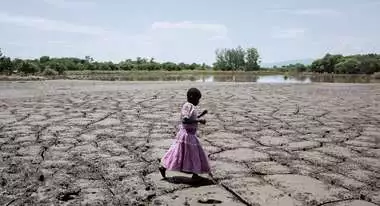Should climate funds be used for social security?
By Nicholas Sitko, Marco Knowles and Garima Bhalla, UN Food and Agriculture Organization (FAO)
If financial assistance to address climate change is used more for the social protection of rural communities, it will facilitate more equitable adaptation – and ultimately strengthen climate protection.
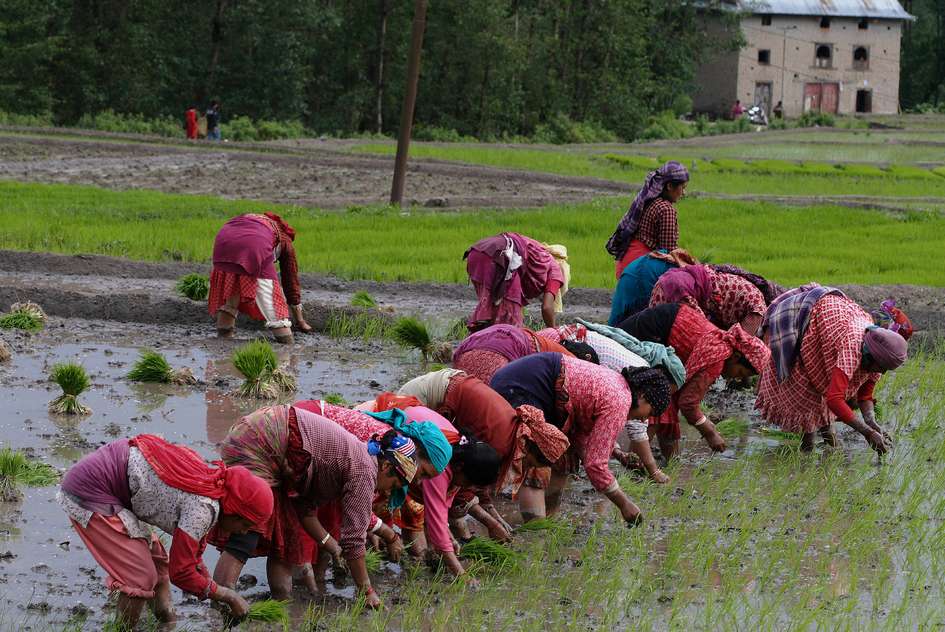
Rising temperatures and increasingly frequent and intense weather events due to climate change are imperiling progress towards achieving the Sustainable Development Goals (SDGs). Rural people – many of who are small-scale farmers - are particularly vulnerable due to their dependency on natural resources, poverty, limited access to services and resources, and a lack of infrastructure.
They are also a critical part of the solution. While small-scale farmers are not major contributors to global emissions, they are custodians of the world’s major natural ecosystems. We are witnessing a paradox in climate finance: while small-scale farmers are among the most vulnerable to climate change and can play a major role in reducing emissions, they receive only 1.7% of climate finance.
Social protection interventions aim to reduce social and economic risks and vulnerability, and to alleviate extreme poverty and deprivation. Social protection can also play an important catalytic role in enabling rural populations to benefit from, and participate in, efforts to mitigate and adapt to climate change. However, coverage of social protection is still far too low. For instance, in low-income countries, 80 percent of the poorest rural households have no access to social protection. A further concern is that the countries that are most exposed to climate risks are the ones with the lowest coverage of social protection.
It is critical to use climate finance for expanding coverage of social protection to rural populations and in turn making progress in climate adaptation and mitigation goals. This can help to realize a more inclusive, just, and effective response to the climate crisis.
Climate adaptation is costly and risky for small-scale farmers
Adapting to climate change entails substantial costs and risks that poor and vulnerable rural populations cannot afford. As a result, the adoption of climate adaptation practices is often quite low and where adoption occurs, it tends to be concentrated among better-off farmers that can pay for the upfront costs and handle the risks.
Due to poverty and lack of access to credit, insurance and basic services, the decision-making of poor farmers focuses mainly on meeting their day-to-day needs at the cost of long-term investments and returns. For instance, they may have to sacrifice sending children to school so as to be able to afford a meal or they may have to fell trees to use as firewood rather than keeping them as protective cover for their land. These decisions and vulnerabilities lock people into poverty traps, making them more vulnerable to future climate risks.
In addition, efforts to mitigate greenhouse gas emissions (GHG) from agriculture and land use can undermine the welfare of rural people. Mitigation typically entails protecting forests and natural ecosystems, reducing fertilizer use, afforestation, and production of biofuels (IPCC, 2022). These mitigation efforts can limit farmers’ options for agricultural production and decrease their incomes (Hasegawa et al., 2018). Thus, climate change, as well as the very actions to mitigate it, risk further increasing inequalities, poverty and food insecurity.
Social protection enables small-scale farmers to invest in new technologies, diversify incomes, adopt new farming assets and accumulate savings, to better adapt to climate change. Research shows that by providing rural people with predictable and stable income, social protection can reduce barriers to climate change adaptation and make rural communities more resilient to future climate shocks. This occurs through various channels.
Evidence shows that social protection programs support rural people in purchasing new technologies and inputs, such as improved seeds. In Zambia, for example, cash transfers increased spending on agricultural inputs by beneficiaries by 242 percent (Handa et al 2018). Similarly, in Lesotho cash transfers increased seed and fertilizer expenditures by 70 and 86 percent respectively (Daidone et al. 2021).
It is critical to diversify sources of incomes since this can help stabilize incomes and consumption in times of weather shocks. This is particularly important for weather dependent small-scale farmers. In Zambia and Malawi, the Child Grant model and Social Cash Transfer Program beneficiaries increased participation in non-farm business by 17 and 12 percentage points respectively (Handa et al. 2018; de Hoop et al. 2020). In Ethiopia, beneficiaries of the Productive Safety Net Program are 6.7 percentage points more likely to operate non-farm enterprises (Gilligan et al., 2009).
Climate adaptive farm management practices can take many years to yield results and benefits may only be discernible when shocks occur. As a result, only few farmers apply these practices. However, access to social protection can help address these barriers. For example, the access to the Malawi Social Action Fund, a public works program, is associated with farmers’ increased and sustained adoption of soil and water conservation and organic fertilizer since it enables farmers to afford the costs and manage the uncertainty associated with adopting new technologies (Scognamillo and Sitko 2021).
The impacts of social protection on asset accumulation and savings also tend to be positive. Valuable livestock assets are of particular interest, because they can be sold when shocks occur and are more resistant than crops to extreme weather events. In Niger, for example, beneficiaries of the government-led cash plus programme increased their livesotck holdings by 56 percent relative to the comparision group (Bossuroy et al, 2022). In terms of savings, a range of other studies find positive impacts on savings rates and quantities saved by social protection beneficiaries (Daidone et al 2019).
Social protection contributes to reducing GHG emissions
Public employment programmes help mitigate climate change and simultaneously increase welfare and climate adaptive practices among rural populations. For example, public work programmes have been used in Ethiopia and India to support large-scale soil conservation, develop irrigation infrastructure, promote reforestation, and develop community assets such as roads and grain storages. In Ethiopia, studies have found that public works increased tree cover by 3.8%, leading to carbon sequestration equivalent to about 1.5% of Ethiopia’s annual emissions reduction pledged by 2030 (Hirvonen et. al 2022.)
There are also social protection programmes that make payments on condition that their clients adopt mitigation and adaptation actions. Paraguay’s Poverty, Reforestation, Energy and Climate Change (PROEZA) programme, provides households participating in the country’s flagship social protection scheme, Tekoporã, with technical support and additional cash, on condition that they adopt sustainable agroforestry production practices. Similarly, in Brazil, the Bolsa Verde programme provides cash payments to beneficiaries of the national social cash transfer programme, Bolsa Familia, in exchange for maintaining or restoring forests, protecting water sources, and promoting sustainable agriculture.
Social protection alone, however, will not be sufficient. Data and information on climate risks, training on climate adaptation practices, and functional markets for agricultural inputs (e.g. seeds, fertilizers and tools) and labour are also necessary to make small-scale farmers more climate-resilient.
Social protection goes beyond emergency relief
The global climate policy discourse increasingly recognizes the important role of social protection in helping to manage the adverse effects of climate change. The sixth Assessment Report of the Intergovernmental Panel on Climate Change of working group II, for example, mentions social protection around 100 times, which is twice as often as the previous report. The picture is, however, is bleaker, when it comes to the national level: only few countries recognize social protection in their climate adaptation strategies and plans.
Furthermore, in the global climate policy discourse, social protection is being largely discussed as an emergency relief tool to help households cope with the immediate impacts of climatic shocks, like droughts and floods. Take, for example, the most recent financing initiatives. The Global Shield, which financially supports rapid responses to climate disasters, makes specific reference to the role of social protection as an instrument“to provide rapid financial assistance to households and businesses to act early against and respond to climate and disaster related losses” (G7, 2022). In a similar vein, the loss and damage fund that countries agreed to create at COP 27 (UNFCC, 2022), appears to focus on compensating for losses and damages. As such, any financing directed towards social protection through this fund also likely responds to the immediate aftermaths of climate shocks.
But social protection programmes in the context of climate actions should go beyond emergency relief, especially when they are combined with well-designed complementary interventions. They help to achieve more inclusive climate actions and to increase climate resilience among rural populations.
Major climate financing funds, such as the Global Environment Facility (GEF) and Green Climate Fund (GCF), provide scope for financing social protection interventions and for making fundamental investments in social protection systems (GEF, 2022; GCF 2022). However, the cases in which these funds have been used to finance social protection are unfortunately still scant. We therefore need much stronger efforts to use climate finance to integrate social protection into climate actions and thereby contribute to more inclusive, just, and effective investments.
References:
Bossuroy, Thomas, Markus Goldstein, Bassirou Karimou, Dean Karlan, Harounan Kazianga, William Parienté, Patrick Premand, et al. 2022. “Tackling Psychosocial and Capital Constraints to Alleviate Poverty.” Nature 605 (7909): 291–97. https://doi.org/10.1038/s41586-022-04647-8.
Daidone, Silvio, Noemi Pace, and Ervin Prifti. 2021. Evaluation of Lesotho’s Child Grants Programme (CGP) and Sustainable Poverty Reduction through Income, Nutrition and Access to Government Services (SPRINGS) Project. FAO and UNICEF. https://doi.org/10.4060/cb4862en.
G7. (2022). Global Shield against Climate Risks: German G7 Presidency and V20 Concept for Consultation. Berlin and Accra, 21 September 2022. Available here: https://www.bmz.de/resource/blob/127498/global-shield-against-climate-risks-concept-barrierefrei.pdf
Gilligan, Daniel O., John Hoddinott, and Alemayehu Seyoum Taffesse. 2009. “The Impact of Ethiopia’s Productive Safety Net Programme and Its Linkages.” Journal of Development Studies45 (10): 1684–1706. https://doi.org/10.1080/00220380902935907.
GEF. (2022). GEF Programming Strategy on Adaptation to Climate Change for the Least Developed Countries Fund and the Special Climate Change Fund for the GEF-8 period of July 1, 2022, to June 30, 2026 and Operational Improvements. Washington DC. Available here: https://www.thegef.org/sites/default/files/documents/2022-06/EN_GEF.LDCF_.SCCF_.32.04.Rev_.01_GEF%20Programming_Strategy_Adaptation_Climate_Change_LDCF_SCCF_GEF8_July_2022_June%202026_Operational_Improvements.pdf
Handa, Sudhanshu, Frank Otchere, Paul Sirma, and the Evaluation Study Team. 2022. “More Evidence on the Impact of Government Social Protection in Sub‐Saharan Africa: Ghana, Malawi, and Zimbabwe.” Development Policy Review 40 (3). doi.org/10.1111/dpr.12576.
Handa, Sudhanshu, Luisa Natali, David Seidenfeld, Gelson Tembo, and Benjamin Davis. 2018. “Can Unconditional Cash Transfers Raise Long-Term Living Standards? Evidence from Zambia.” Journal of Development Economics 133 (July): 42–65. doi.org/10.1016/j.jdeveco.2018.01.008.
Hasegawa, T., Fujimori, S., Havlík, P., Valin, H., Bodirsky, B. L., Doelman, J. C., ... & Witzke, P. (2018). Risk of increased food insecurity under stringent global climate change mitigation policy. Nature Climate Change, 8(8), 699-703.
Hirvonen, K., Machado, E. A., Simons, A. M., & Taraz, V. (2022). More than a safety net: Ethiopia’s flagship public works program increases tree cover. Global Environmental Change, 75, 102549.
Hoop, Jacobus de, Valeria Groppo, and Sudhanshu Handa. 2020. “Cash Transfers, Microentrepreneurial Activity, and Child Work: Evidence from Malawi and Zambia.” The World Bank Economic Review 34 (3): 670–97. https://doi.org/10.1093/wber/lhz004
Scognamillo, Antonio, and Nicholas J. Sitko. 2021. “Leveraging Social Protection to Advance Climate-Smart Agriculture: An Empirical Analysis of the Impacts of Malawi’s Social Action Fund (MASAF) on Farmers’ Adoption Decisions and Welfare Outcomes.” World Development146 (October): 105618. doi.org/10.1016/j.worlddev.2021.105618.
UNFCC. (2022). Funding arrangements for responding to loss and damage associated with the adverse effects of climate change, including a focus on addressing loss and damage. Available here: unfccc.int/documents/624440
